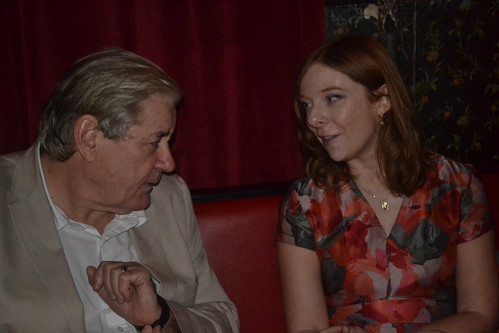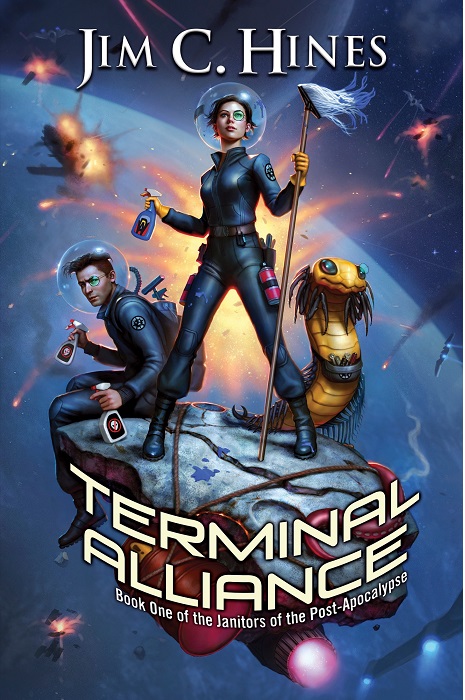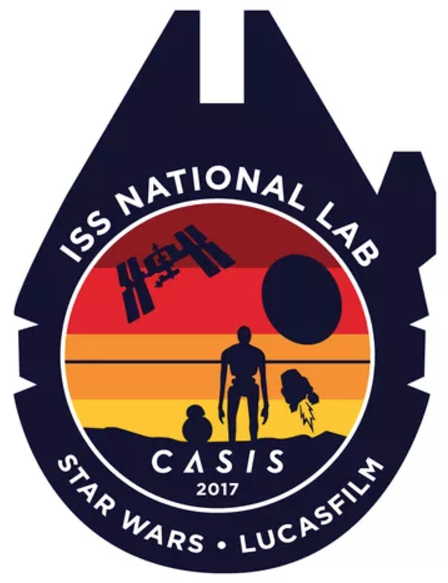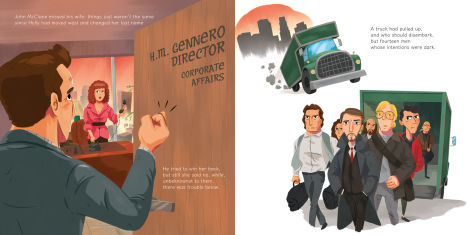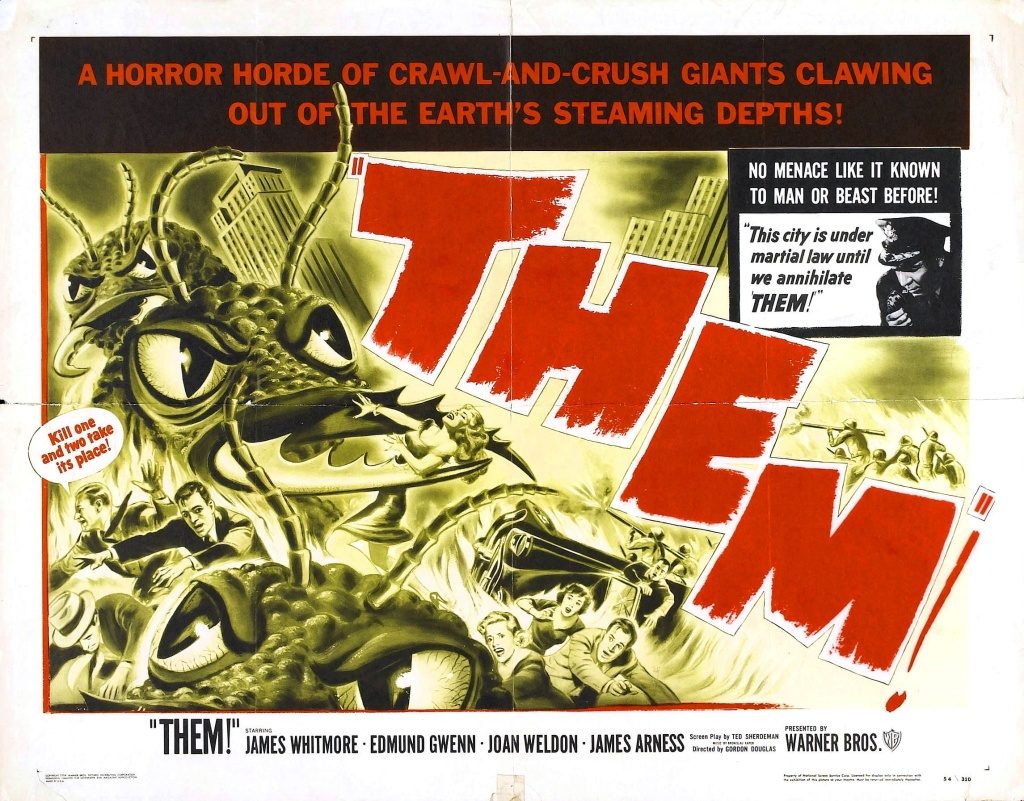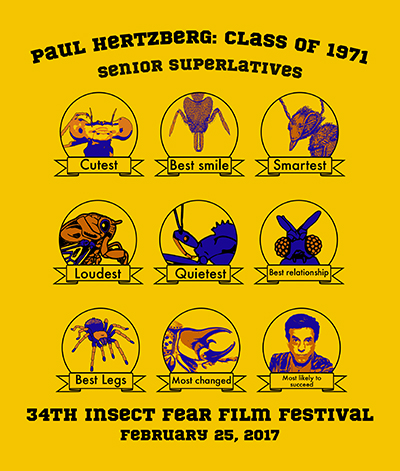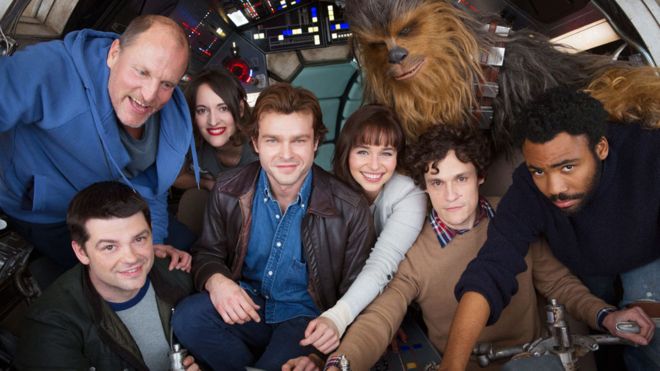(1) SAN DIEGO 2049. The School of Global Policy and Strategy is celebrating its 30th anniversary by partnering with the Arthur C. Clarke Center for Human Imagination to produce San Diego 2049, “a series of programs through 2018-19 that will use the imagination and narrative tools of science fiction to stimulate complex thinking about the future and the ways we could shape it through policy, technology, innovation, culture, and social change.”
If we are to leave the earth in better shape than we found it, successful social choices will require us to imagine distant alternate futures that reflect our best knowledge about how humans behave and evolve socially, politically, and cognitively. Science fiction gives us the needed space for long-range speculation and the complex interactions of technological, political, and social change.
Imagining the future helps us react to unanticipated situations–futures that we did not imagine. This competition and event series foster diverse visions for San Diego in 2049 from UC San Diego graduate students and draws on research by faculty across divisions. By bringing together students, science fiction writers, faculty, policy makers, and industry experts, we aim to foster the kind of multi-modal, boundary-crossing thinking that we need today to anticipate the potential shape of the world thirty years from now.
The Opening Events include a lecture by Vernor Vinge that is free and open to the public, and a workshop with Ann Pendleton-Jullian that is limited to participating UCSD graduate students.
Opening Events:
WORLDBUILDING: SCENARIOS, FOR FUN AND FOR SURVIVAL
PROGRAM KICKOFF PUBLIC LECTURE WITH VERNOR VINGE
October 12, 5 – 7pm, Robinson Auditorium, UC San Diego
Free and open to the public; RSVP required (click here)
Light reception to follow
Learn about the complex process of science fiction worldbuilding to construct a dynamic future scenario with one of the masters of the field, Vernor Vinge.
The much acclaimed science fiction writer Vernor Vinge is author, among other books, of Rainbows End, which takes place, in part, on a future UC San Diego campus. Vinge has won five Hugo Awards, including one for each of his last three novels, Upon the Deep (1992), A Deepness in the Sky (1999), and Rainbows End (2006). Known for his rigorous hard-science approach to his science fiction, he became an iconic figure among cybernetic scientists with the publication in 1981 of his novella “True Names,” which is considered a seminal, visionary work of Internet fiction and cyberspace. Dr. Vinge is Emeritus professor of mathematics and computer science at San Diego State University and also noted, among other things, for introducing the term “the singularity.”
(2) HARD SF 2017. Rocket Stack Rank has compiled its annual short story selection of “Outstanding Hard Science Fiction” from 2017.
There are 33 outstanding stories of hard science fiction from 2017 that were either finalists for major SF/F awards , included in “year’s best” SF/F anthologies , or recommended by prolific reviewers in short fiction (see Q&A). That’s 33 out of 95 hard science fiction stories from that year, and out of 279 outstanding SF/F stories from 2017.
Observations:
- 20 are free online (click to see yellow highlights).
- 7 (almost 1/4) are from Analog Science Fiction.
- The most prolific authors in this list are Suzanne Palmer, Alastair Reynolds and Jay Werkheiser with 2 stories each.
- RSR recommended 15 of the stories and only recommended against 3.
(3) HELP WANTED. Social media help, that is. SF2 Concatenation is seeking to approach scientists (those with a BSc degree in science, technology, engineering, maths/medicine [STEM]) who are also professional SF authors: those published by a commercial SF/F genre imprint, to contribute to a special series of articles — “SF authors who are scientists wanted”.
We at SF2 Concatenation have been running a series of short articles by SF authors (folk who have had at least two or more SF books commercially published) who have a degree in science, engineering, mathematics of medicine. These identify the top ten scientists born in the 20th century that have inspired the scientist SF authors (and by implication perhaps part of their science fiction writing?).
…What we would like you – our readers – to do is to let any SF authors you know who have a science/maths etc, degree know of this series by sending them the link to this page and then they can get in touch with us. And/or you can get in touch with us yourself and nominate a potential contributor to this series.
You can also spread the word on your social media linking to this article.
Potential scientist authors need not currently be working in science but must have a science degree.
(4) MOOMIN PICTURES. Nicholas Whyte tells why he enjoyed “Five Moomin books, by Tove Jansson”, including Comet in Moominland —
This was the first full Moomin novel, pubished in 1946 but written in the shadow of war, and it’s not too difficult to see the metaphor of the world-altering disaster threatened here in the shape of a comet aproaching the Earth. Against this ominous background, Moomintroll, who is the central character of most of the Moomin books, along with Sniff (who fulfills a younger sibling role) and Snufkin (the Best Friend) go to the Observatory to ask advice from the Astronomer. On the way they make friends with two more siblings, the Snork and the Snork Maiden. After a series of adventures (including a dragon and a carnivorous tree), they get to the Observatory and there the Astronomer nonchalantly informs them that there is no hope – the comet will destroy everything. They return home across a devastated landscape with scurrying refugees, and at the last moment as they prepare for the end, all comes right and the world is saved.
(5) DO MORE THAN JUST RUB TWO STICKS TOGETHER. The B&N Sci-Fi & Fantasy Blog’s Ross Johnson declares that “How to Invent Everything Is a Hilariously Essential Guide for Would-Be Time Travelers”.
…The book is purportedly a guide for time travelers, made from futuristic materials and discovered embedded in pre-Cambrian rock. At some point in the future, a Chronotix Solutions will invent the FC3000(tm) personal time machine. Individuals may lease the machine for travel to any point whatsoever in history and, given the particular theory of time travel at play here, do whatever they wish in the past. Since visits to the past generate alternate timelines, there’s no conceivable way to do any damage to the traveler’s original timeline. Successful journeys return the Traveller to their original frame of reference, but the stranded will find themselves stuck in a newly created timeline branching off from the moment of their arrival.
The book suggests a novel solution for the stranded: figure out when you are, and then rebuild civilization from the literal ground up as a means of making life bearable…
(5) PUMPING THE BRAKES. ScreenCrush says “Disney Plans Star Wars Franchise ‘Slowdown’”:
[CEO] Iger says he now believes Disney’s approach to Star Wars was “too much, too fast.” And there will be an adjustment moving forward:
I made the timing decision, and as I look back, I think the mistake that I made — I take the blame — was a little too much, too fast. You can expect some slowdown, but that doesn’t mean we’re not gonna make films. J.J. [Abrams] is busy making [Episode] IX. We have creative entities, including [Game of Thrones creators David] Benioff and [D.B.] Weiss, who are developing sagas of their own, which we haven’t been specific about. And we are just at the point where we’re gonna start making decisions about what comes next after J.J.’s. But I think we’re gonna be a little bit more careful about volume and timing. And the buck stops here on that.
(6) KGB READINGS. Ellen Datlow has posted photos from Fantastic Fiction at KGB’s September readings:
Patrick McGrath read from his most recent novel, a ghost story titled THE WARDROBE MISTRESS and Siobhan Carroll read excerpts from a short story she recently finished.
(7) GETTING READY FOR IRELAND. Something of general interest, and possibly a bit of prep a person might do before traveling to Dublin 2019 — “Free Online Course on the Book of Kells starts next month”.
A new, free, online course developed by Trinity College Dublin will allow learners worldwide to explore the history of Ireland through the remarkable Book of Kells — one of the world’s most famous medieval manuscripts.
… Now members of the public around the world will have the opportunity to learn more about this precious manuscript through a new four-week online course. The “Book of Kells: Exploring an Irish Medieval Masterpiece” course will start on October 8th, 2018 and is run in partnership with Futurelearn, the social learning platform. The free online course is aimed at anyone with an interest in Ireland, medieval studies, history, art, religion and popular culture.
(8) TODAY’S BIRTHDAYS
[Compiled by Cat Eldridge.]
- Born September 20, 1878 – Upton Sinclair. Writer of — and would I kid you? — The Gnomobile: A Gnice Gnew Gnarrative With Gnonsense, but Gnothing Gnaughty. They’re gnomes which makes them genre. And Walt Disney himself produced it as a film shortly before his death. Mind you it was released as The Gnome-Mobile.
- Born September 20, 1916 – Bradford M. Day. He’s best known as an early bibliographer of science fiction and fantasy. Some of his pubs which are archived in the University of Texas System include The Complete Checklist of Science-Fiction Magazines which is complete up to the late 50s, Edgar Rice Burroughs Biblio: Materials toward a Bibliography of the Works of Edgar Rice Burroughs and Talbot Mundy Biblio: Materials toward a Bibliography of the Works of Talbot Mundy. Anyone recognize the last author?
- Born September 20, 1935 – Keith Roberts. Best known I think for Pavane where the Catholic Church holds brutal rule over England after the assassination of Queen Elizabeth I. It like most of his novels were a series of linked short stories. There’s a rather good collection of ghost stories by him, Winterwood and Other Hauntings, that has an introduction by Robert Holdstock.
- Born September 20 – George R.R. Martin, 70. Setting aside A Game of Thrones which is hardly limited to those novels, there’s The Armageddon Rag and Dying of the Light set in his Thousand Worlds universe which I really l like among his myriad novels. There’s a very nice compilation of his excellent short fiction, Dreamsongs: A RRetrospective (not a typo) and I recommend A Song for Lya as well as it’s a collection focused on his early short fiction. Awards? Hugos and Nebulas, Bram Strokers and so forth almost beyond count.
- Born September 20 – James P. Blaylock, 58. Writer of the Balumnia trilogy which the author says was inspired by The Wind in The Willows and The Hobbit. Other works include the Narbondo series which has two Victorian London steampunk novels which are wonderful. All of the these stories are collected in The Adventures of Langdon St. Ives. He won World Fantasy Awards for his “Thirteen Phantasms” and “Paper Dragons” stories.
(9) MAJOR PICTURES. Michael Dooley publicizes the just-released DC Comics Before Superman: Major Malcolm Wheeler-Nicholson’s Pulp Comics in his post “Pulp Fiction Facts: the Secret Origin of Comic Books”:
If you’re a fan of Golden Age comic book stories with plenty of action thrills, you should know about the military intelligence officer Malcolm Wheeler-Nicholson. Here’s how Jim Steranko, Silver Age superstar artist on Captain America and Nick Fury, describes him: “He adventured around the globe, from hunting Mexican revolutionary Pancho Villa with famed General John Pershing to fighting with Cossack warriors across Russia during WWI. … As one of the youngest cavalry members serving his country, Wheeler-Nicholson faced enemies from the Philippines to Siberia.” This character could have been the star of his own comics during those early, anything-goes 1930s and ’40s, or the hero of numerous 1920s and ’30s pulp fiction tales. And in a way, he was both….
Most of the first comics publishers came from a background in pulps, but as salesmen. The Major was the only one with the kind of creative background that greatly enhanced his understanding of genre fiction and story structure. It also gave him empathy for his artists and writers, as he crusaded for their financial equality and ownership rights. Nicky’s text provides background details as seen through her eyes and research. They’re interspersed throughout the book, which primarily displays the Major’s seldom-seen comics, drawn by a variety of artists including Jerry Siegel and Joe Schuster, whose careers he was instrumental in launching….
“Jerry Siegel was submitting the Superman story in many different places in the attempt to get it published. … Many people in the burgeoning and close-knit industry knew about the comic, and several had turned it down. There was only one person in that publishing arena who believed in Superman from the very beginning: Major Malcolm Wheeler-Nicholson. … Jerry Siegel would later remark, ‘And so, because Nicholson had not tossed away the wrapping paper sketches, Joe and I broke into print.’”
(10) SET PHASERS TO EPONYMOUS. Space.com makes note that a planet has been found in the canonical place for Mr. Spock’s home (“Hey, Spock! Real-Life ‘Planet Vulcan’ Orbits Sun Featured in ‘Star Trek’“).
“Star Trek’s” planet Vulcan, ancestral home of Spock and his species, just became a little more real, thanks to a team of exoplanet scientists.
Because “Star Trek” creators eventually associated planet Vulcan with a real star, called 40 Eridani A, scientists have wondered for years whether a factual equivalent of the beloved science fiction planet exists, with or without pointy-eared inhabitants. And now, a team of scientists has said that the star really does host at least one planet.
“This star can be seen with the naked eye, unlike the host stars of most of the known planets discovered to date,” Bo Ma, lead author of the new research and an astronomer at the University of Florida, said in a statement. “Now, anyone can see 40 Eridani A on a clear night and be proud to point out Spock’s home.” …
GUYS WAIT WHOA WHOA WHOA.
I did not realise at the time because they published the star under a different name, but WE FOUND A PLANET AROUND 40 ERIDANI A.
*crickets*
THAT'S WHERE SPOCK IS FROM. VULCAN ORBITS 40 ERIDANI A.
WHAT.https://t.co/fojauzTgok pic.twitter.com/xL6imUmxfu
— Dr. Jessie Christiansen @ #ExSSV (@aussiastronomer) September 18, 2018
(11) CONGRATULATIONS. Galactic Journey’s Gideon Marcus takes time out for “A Word From Our Sponsor”.
Last month, I transitioned from amateur author to professional. My first published short story, Andy and Tina, is the lead novelette in the anthology, Tales from Alternate Earths 2 (sequel to the Sidewise Award-winning Tales from Alternate Earths).
My piece starts in 1963 and features some fascinating elements of the Space Race. I’m told by folks who aren’t even related to me that it’s a great read, as are the other nine stories in the volume. I would be absolutely delighted (and I think you will be, too) if you would purchase a copy. If you like my prose, and you must if you’re still here, you’ll love this book.
So go get yourself a copy! You’ll be supporting the Journey, and you’ll be the proud owner of a fantastic book.
(12) INSPIRED HOMAGES. Scott Edelman’s “Tell Me Like You Done Before” is on sale from Lethe Press:
Wonderful and wry pastiches! Scott Edelman’s newest collection brings together his fiction inspired by master storytellers – Edgar Allan Poe, John Steinbeck, Alice Sheldon among others. Herein can be found the Shakespearean riff of a living son of the mayor of New York City falls in love with the daughter of the zombie king, a Bradburyesque aged carnival attraction who promised patrons immortality, and a Wellsian figure deals with the impossibility of miracles. The collection features notes by Edelman that offer insight into each story’s birth and the importance of the storyteller he sought to emulation.
I’m confident in guessing “The Final Charge of Mr. Electrico” is the Bradbury one.
(13) THE ATLANTIC’S DOPEST CRUSTACEANS. My question is how somebody who’d worry about this could convince themselves to eat a lobster at all — “Maine restaurant sedates lobsters with marijuana”.
A growing body of scientific findings suggest that not only lobsters but other invertebrates, such as crayfish and crabs, are able to feel pain.
The owner of Charlotte’s Legendary Lobster Pound, Charlotte Gill, says eating the sedated lobster will not make customers high and using marijuana leads to better quality meat, as the animal is more relaxed when it dies.
(14) ANOTHER REEFER PLAN. “Jellyfish robots to watch over endangered coral reefs” — can look for reef damage without doing damage itself the way a drone with a propeller would.
A fleet of robotic jellyfish has been designed to monitor delicate ecosystems, including coral reefs.
The underwater drones were invented by engineers at Florida Atlantic University and are driven by rings of hydraulic tentacles.
The robots can squeeze through tight holes without causing damage.
One expert praised the design but warned that the man-made jellyfish might be eaten by turtles.
(15) APEX MAGAZINE. They need a basic number of subscribers to keep their print edition going – if you want to be one of them see details here.
Starting to plan out 2019, and I have to say, I'm beginning to get a bit worried about the print edition of @apexmag. We need at least 75 subscribers to continue and we're currently 12 short. If you want to see it continue, help spread the news. Subscribe! https://t.co/emtER2myIb
— Apex Publications (@ApexBookCompany) September 18, 2018
(16) LET ROVER COME OVER. BBC reports “Hayabusa-2: Japan’s rovers ready for touchdown on asteroid”.
Japan’s space agency is preparing to deploy two robotic explorers to the surface of an asteroid.
On Friday, the Hayabusa-2 spacecraft will despatch a pair of “rovers” to the 1km-wide space rock known as Ryugu.
Rover 1A and Rover 1B will move around by hopping in Ryugu’s low gravity; they will capture images of the surface and measure temperatures.
Hayabusa-2 reached the asteroid Ryugu in June this year after a three-and-a-half-year journey.
(17) SORTING OUT SESAME STREET. John Scalzi analyzes the perpetual Bert and Ernie controversy as part of “The Whatever Digest, 9/20/18”.
I posted the tweet above the other day about the recent contretemps regarding whether Bert and Ernie are a gay couple, which was prompted by one of Sesame Street’s former writers noting he always wrote them as if they were a gay couple, which in turn prompted but Sesame Workshop and Frank Oz (creator of Bert) to aver that they were not, which in turn made Twitter explode, because, well, Twitter….
It can be truly said that Frank Oz, when he created him, did not think of Bert as being gay; it can also be truly said that at least one writer on Sesame Street, when writing Bert and Ernie, wrote them as a gay couple; it can also be truly said that the Sesame Workshop, at least publicly, doesn’t want Bert and Ernie to be considered as beings with sexuality at all….
(18) TO BE NAMED LATER. SYFY Wire brings news of a new female led ABC series from the Marvel Cinematic Universe (“Marvel is developing a female-centric superhero show at ABC”)—they just don’t know what superhero will take the lead.
…Marvel is apparently looking for more female heroes on the small screen. Now, with the MCU currently thriving on Netflix, Hulu, and Freeform, an all-new female-fronted Marvel series is in the works at ABC.
According to Deadline, a new superhero show is being developed by the network, which launched the TV side of the MCU with Marvel’s Agents of S.H.I.E.L.D. back in 2013. Allan Heinberg, who wrote DC’s big screen adaptation of Wonder Woman, will be writing the series. Details are still scarce, but it’s reported to be an hour-long drama focusing on lesser-known female superheroes in the Marvel canon.
The complete lack of info on the lead didn’t stop the article’s writer, Christian Long, from taking a few guesses:
An obvious guess would be A-Force, the first all-female Avengers team that resulted from a Secret Wars crossover in 2015. They were also led by She-Hulk, who would certainly be a welcome addition to the MCU. Another possibility is Lady Liberators, who, despite a tone-deaf one-off appearance in Avengers #83 in 1970, was re-launched in 2008. It’s worth noting that they were also led by She-Hulk.
There’s also the Fearless Defenders, though they were led by Misty Knight and Valkyrie. The former is a major character in Netflix’s Luke Cage, played by Simone Missick, while the latter is portrayed on the big screen by Tessa Thompson, so neither character would likely be available.
(19) CUMBERBATCH VOICES DR. SEUSS CHARACTER. The Grinch Movie comes to theaters November 9.
The Grinch tells the story of a cynical grump who goes on a mission to steal Christmas, only to have his heart changed by a young girl’s generous holiday spirit. Funny, heartwarming and visually stunning, it’s a universal story about the spirit of Christmas and the indomitable power of optimism. Academy Award® nominee Benedict Cumberbatch lends his voice to the infamous Grinch, who lives a solitary life inside a cave on Mt. Crumpet with only his loyal dog, Max, for company.
[Thanks to John King Tarpinian, Martin Morse Wooster, JJ, Cat Eldridge, Eric Wong, Chip Hitchcock, Mike Kennedy, Carl Slaughter, ULTRAGOTHA, SF Concatenation’s Jonathan Cowie, and Andrew Porter for some of these stories. Title credit goes to File 770 contributing editor of the day Robert Whitaker Sirignano.]


